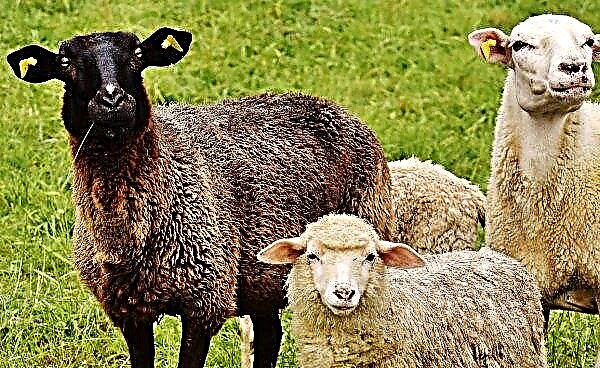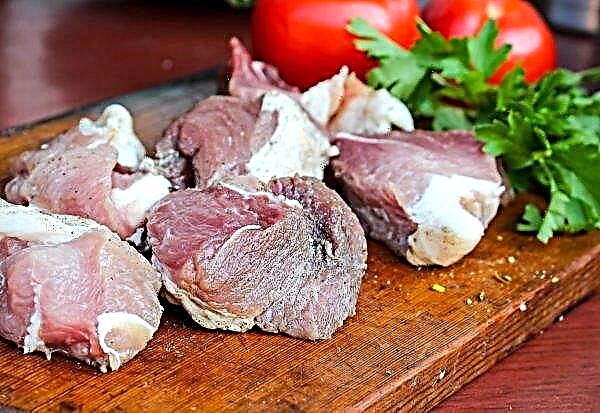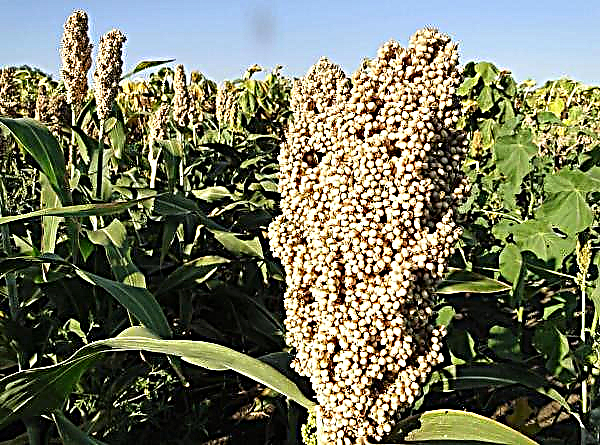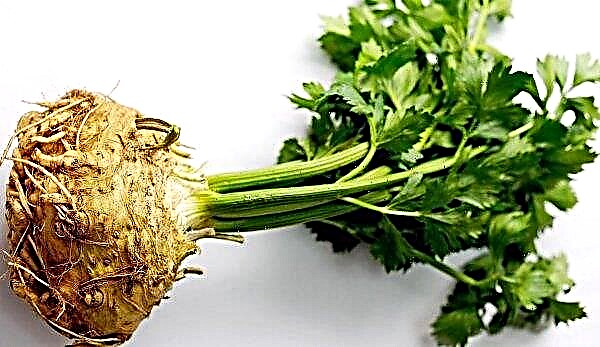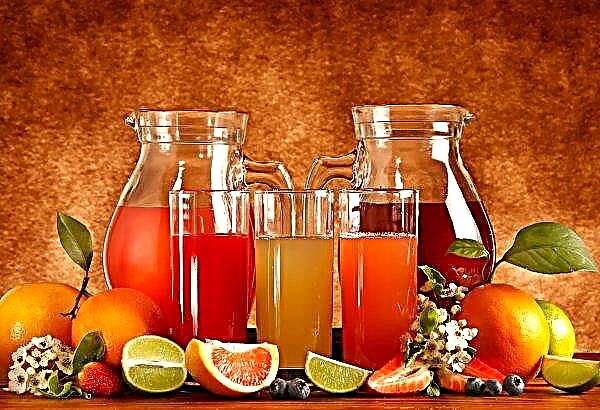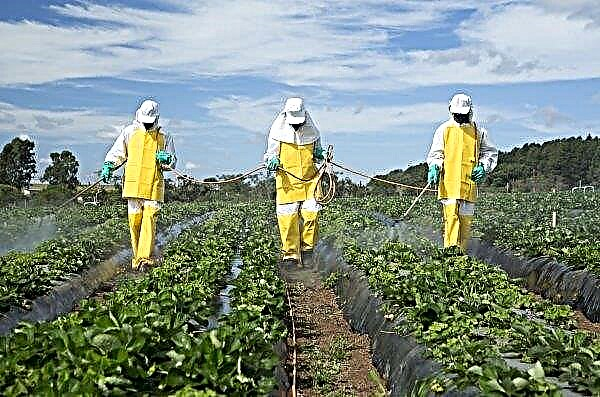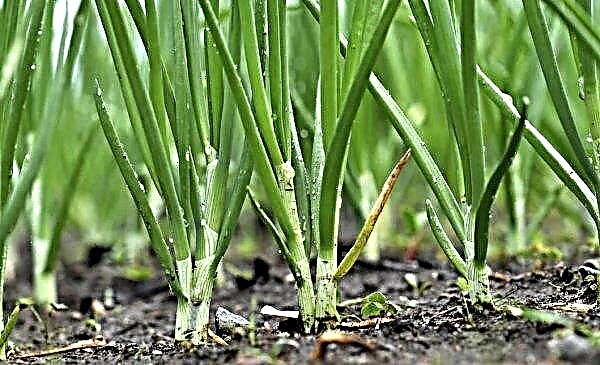Every farmer knows that the health and productivity of chickens depends on their diet from the moment they are born. In conditions of a large economy, it is rather expensive to calculate the required amount of each type of feed and prepare it, so the ready-made mixture comes to the aid - feed. When and how to start giving it to chickens, whether it is possible to cook it yourself, which compound feed from the ones offered in the store is better - we will talk about this later.
Is it possible to feed chickens with compound feed?
Specially designed mixed feed chicks can be fed from birth. It is necessary to distinguish between 2 concepts:
- Feed mixture - is made by mixing different types of grain.
- Compound feed that fully meets the nutritional requirements - is made from a mixture of grain, additionally enriched with other substances.
 This method of feeding has advantages and disadvantages.
This method of feeding has advantages and disadvantages.Benefits
- The following advantages can be distinguished in feeding chickens with compound feed:
- Strengthening the immune system of babies, their ability to resist diseases.
- Ensuring proper nutrition of chickens due to the content of vital substances.
- There is no need to additionally feed the bird, producers have already taken care of the balance of the feed.
- The level of viability of the chicks increases, growth accelerates.
- Reduces feed consumption.
Disadvantages
- Of the shortcomings of such nutrition can be called:
- The highest price of the product.
- High wheat foods can impair digestion.
- Constant water availability is required.
- Incorrectly selected compound feed, unnatural composition can worsen the health of babies.
The composition of the feed
According to the age of chickens, there are such compound feeds:
- starting - up to 14 days;
- growth - up to 30 days;
- finish - older than a month.
 The main components of start feed:
The main components of start feed:- grains of corn, barley, peas, wheat;
- vitamins;
- minerals;
- flour from fish;
- soda;
- limestone;
- fat from plants;
- phosphates;
- antioxidants;
- amino acids.
 Compound feed for the growth of chicken offspring is characterized by a lower degree of grinding and includes:
Compound feed for the growth of chicken offspring is characterized by a lower degree of grinding and includes:- corn;
- cake of soy and sunflower;
- yeast;
- fish and meat meal;
- limestone;
- vitamins;
- minerals;
- amino acids;
- fermenting substances;
- phosphates;
- antioxidant.
Important! If you want to transfer offspring to feed growth from starter feed or another type of feeding, grind it the first few times.
Finishing feed is different from growth feed with an increased portion of the protein in the composition, this is achieved by adding more to it:
- wheat;
- legumes;
- yeast
- oilcake;
- meat, bone and fish meal.
 The granule size of such feed is much larger.
The granule size of such feed is much larger.
Do-it-yourself chicken feed preparation
You can learn how to make feed yourself, if you study the proportions and rules of its preparation.
Proportions
The following products should be included with the feed for babies.
The main components of feed for future chickens
| The name of the constituent elements | Specific weight% |
| Starting | |
| Corn | 48 |
| Wheat | 13 |
| Barley | 11 |
| Sunflower meal | 10 |
| Soybean meal | 8 |
| Fish flour | 6 |
| Skimmed milk powder | 2 |
| a piece of chalk | 1 |
| Sunflower oil | 1 |
| Total | 100 |
| Height | |
| Corn | 48 |
| Wheat | 13 |
| Barley | 11 |
| Linen cake | 10 |
| Soybean meal | 5 |
| Meat meal | 3 |
| Yeast | 3 |
| Peas | 2 |
| Fish flour | 2 |
| a piece of chalk | 1 |
| Sunflower oil | 1 |
| Herbal flour | 0,9 |
| Salt | 0,1 |
| Total | 100 |
| Finishing | |
| Corn | 43 |
| Wheat | 13 |
| Sunflower meal | 10 |
| Soybean meal | 8 |
| Barley | 8 |
| Herbal flour | 5 |
| Yeast | 5 |
| Legumes | 4 |
| Sunflower oil | 1,5 |
| Bone flour | 1 |
| a piece of chalk | 1 |
| Salt | 0,5 |
| Total | 100 |
Instead of milk powder, you can add low-fat kefir to the starter feed.
Mixing technology
Prepared ingredients must be crushed, this can be done using a grain grinder. The starting feed is crushed more strongly, the finishing - not so finely. Then all the components are thoroughly mixed. Can add:
- boiled egg;
- cottage cheese;
- green onions;
- dandelion or nettle leaves;
- carrot;
- cabbage.
 You will also need to intervene one of these additives:
You will also need to intervene one of these additives:
- premix;
- complex of vitamins and minerals;
- each vitamin and mineral individually in such quantity.
Dosage of vitamins and minerals for chicken offspring per 1 kg of feed
| Title | Dosage |
| Vitamins: | |
| A, million IU | 40–50 |
| B1, thousand mg | 10 |
| B2, thousand mg | 30–35 |
| B3 (PP), thousand mg | 150–200 |
| B5, thousand mg | 50–60 |
| B6, thousand mg | 15–20 |
| B7, thousand mg | 250–500 |
| B9, thousand mg | 2,5–5 |
| B12 mg | 100 |
| D3, million IU | 10–15 |
| E, thousand mg | 150 |
| K, thousand mg | 10 |
| Minerals: | |
| Iron, mcg | 20 |
| Manganese, mcg | 45 |
| Copper, mcg | 25 |
| Iodine, mcg | 1 |
Vitamin-mineral complexes and premixes are poured according to the instructions on the package.
Important! Vitamins A, D3 and E are not absorbed without fats, so they must be mixed with vegetable oil before being introduced into the feed.
The best feed from manufacturers
The best feed for chicken offspring today show the following brands:
- "Sun";
- "PC-2";
- "PC-5";
- "PC-6."
"Sun"
The “Sun” compound feed is the start and growth of feed, it can be fed to chicks after hatching. It is completely balanced, so no additional nutrition and supplements are required. Content:
Content:
- corn;
- wheat;
- meal of sunflower and soy;
- fish flour;
- vegetable fat;
- vegetable protein;
- vitamins A, B, C, D, E, K, N;
- iron;
- iodine;
- selenium;
- copper;
- phosphorus;
- cobalt;
- zinc;
- calcium;
- manganese;
- premix.
PC-2
Compound feed "PK-2" is produced for those chickens who are not yet 2 months old. Structure:
- corn;
- wheat;
- sunflower meal;
- flour from fish, meat and bones;
- vegetable fat;
- salt;
- limestone;
- premix (vitamins, minerals, amino acids);
- antioxidant;
- antibiotic;
- coccidiostatic;
- probiotic.
 The manufacturer recommends not to restrict babies in food up to 14 days from birth, then feed 43, 70 and 92 g per 1 individual, increasing the dosage every 7 days.
The manufacturer recommends not to restrict babies in food up to 14 days from birth, then feed 43, 70 and 92 g per 1 individual, increasing the dosage every 7 days.PC-5
Compound feed "PC-5" is available in 3 versions:
- starting;
- height;
- finishing.
It is allowed in the growth phase to continue to feed the starter feed, and then go directly to the finish. The main components:Did you know? There are people in the world who are afraid of chickens, this disease is called electrophobia.
- corn and wheat grain;
- soybean meal;
- oilseed rape;
- rapeseed oil;
- corn gluten;
- sugar beet molasses;
- pork fat;
- baking soda;
- vitamins;
- amino acids;
- phosphate;
- salt;
- limestone.
 Start food from 15 g per day for 1 individual, gradually increase to 30 g by 30 days.
Start food from 15 g per day for 1 individual, gradually increase to 30 g by 30 days.
PK-6
Compound feed "PK-6" is available only in the finish version and is designed for feeding broiler chickens. Contains the following ingredients:
- grain of wheat and corn;
- sunflower meal;
- soybean meal;
- fish flour;
- vegetable oil;
- limestone;
- vitamins;
- minerals;
- salt.
 Starting from 25-30 days from hatching, future chickens are fed 120 g per day for 1 individual, gradually increasing by 50 days to 170 g.
Starting from 25-30 days from hatching, future chickens are fed 120 g per day for 1 individual, gradually increasing by 50 days to 170 g.
Features of feeding chickens
The main task of the farmer when choosing a diet is to ensure normal digestion without a strong load on the fragile stomachs of chickens. At the same time, growing chicks will spend a lot of energy, so you need to take care of food that can replenish its reserves. In order for the digestive system to be formed in accordance with the norms, and in the future the chickens would not have health problems, you need to know how to properly feed the babies in different life cycles.
In the first 2 weeks
In order to "accustom" the gastrointestinal tract of the daily chicken, you need to feed him for 10-12 hours after the appearance. The food for him will be the yolk. At the same time, a little corn grits should be given, sprinkled in a shallow feeder or on a hard surface.
Important! Make sure that all chickens peck. If someone is too weak to peck, mix the boiled yolk with milk and feed through a pipette.
From the first days of life, other types of food are gradually introduced. A diet at this age may look like this.
An approximate menu of chicken offspring from hatching to 2 weeks, g per 1 individual per day
| Title | amount |
| Up to 5 days old | |
| Finely ground grain | 4 |
| Low fat cottage cheese | 1 |
| Hard Boiled Eggs | 2 |
| Low fat kefir | 5 |
| Nettle leaves, dandelion, plantain, green onions, finely chopped carrots | 1 |
| Fish fat | 0,1 |
| Up to 10 days old | |
| Finely ground grain | 7 |
| Oilcake, meal of sunflower, soybean, flax, rapeseed | 0,2 |
| Low fat cottage cheese | 1,5 |
| Hard Boiled Eggs | 2 |
| Low fat kefir | 10 |
| Nettle leaves, dandelion, plantain, green onions, finely chopped carrots | 3 |
| Ground seashells, powdered chalk | 0,2 |
| Bone flour | 0,2 |
| Fish fat | 0,1 |
| Up to 14 days old | |
| Finely ground grain | 11 |
| Oilcake, meal of sunflower, soybean, flax, rapeseed | 0,5 |
| Low fat cottage cheese | 2 |
| Boiled potatoes | 4 |
| Low fat kefir | 15 |
| Nettle leaves, dandelion, plantain, green onions, finely chopped carrots | 7 |
| Ground seashells, powdered chalk | 0,4 |
| Bone flour | 0,4 |
| Salt | 0,05 |
| Fish fat | 0,1 |
Chicken offspring born up to 5 days ago are allowed to eat every 3-4 hours, then reduced to 4 times a day. Food can not be foul, wilted, the remnants of food 40 minutes after the layout needs to be thrown out.
Kids must have impeccable cleanliness, cold water in unlimited access, some recommend adding a little potassium permanganate there for disinfection. Helps strengthen the chicks by adding a 3% solution of glucose or vitamin C.
Did you know? Thanks to experiments on chickens, the Frenchman Louis Pasteur discovered the method of vaccination against cholera, anthrax and rabies.
2 weeks to 1 month
In 2 weeks, the chickens become stronger, they can already grind the products a little larger. The list of products remains the same, the consumption rate is increasing.
An approximate menu of chickens from birth from 2 weeks to 1 month, g per 1 individual per day
| Title | amount |
| Under 21 days | |
| Chopped grain | 13 |
| Oilcake, meal of sunflower, soybean, flax, rapeseed | 0,5 |
| Low fat cottage cheese | 2 |
| Boiled potatoes | 6 |
| Low fat kefir | 17 |
| Nettle leaves, dandelion, plantain, chopped green onions | 5 |
| Carrot | 3 |
| Boiled ground meat | 3 |
| Seashells, limestone | 0,4 |
| Bone flour | 0,4 |
| Fish fat | 0,1 |
| Salt | 0,08 |
| Up to 30 days old | |
| Chopped grain | 18 |
| Oilcake, meal of sunflower, soybean, flax, rapeseed | 0,6 |
| Low fat cottage cheese | 3 |
| Boiled potatoes | 10 |
| Low fat kefir | 20 |
| Nettle leaves, dandelion, plantain, chopped green onions | 7 |
| Carrot | 4 |
| Boiled ground meat | 4 |
| Seashells, limestone | 0,5 |
| Bone flour | 0,5 |
| Fish fat | 0,2 |
| Salt | 0,1 |
At this age, future chickens can be provided with food every 8 hours.
So, feeding chickens with compound feed can significantly save time on cooking food and at the same time get a big return on investment. Modern manufacturers have already included in the composition of their mixtures all the necessary substances, so there is no need for additional nutrition. You can also make food yourself, enriching it with other foods.

